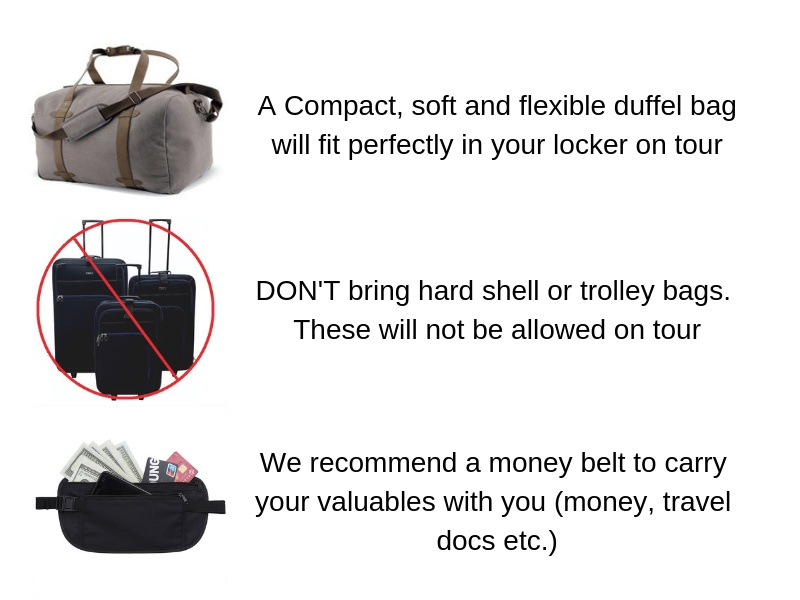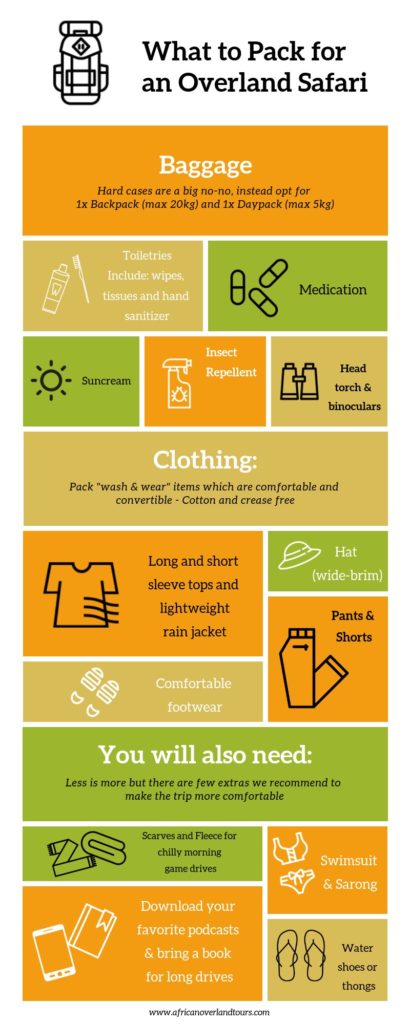Packing sensibly is essential for your Africa trip. One backpack and one daypack are needed and these can weigh no more than 25kg. It is compulsory you take a backpack (and not a suitcase) as the trucks store then in lockers or under the carriage (the locker dimensions vary so please ask your consultant). The airlines implement a 20kg per person limit on international flights for your luggage (your main bag) and a further 5 kg for carry-on luggage (your day bag). A good idea is to include a spare bag for curios that you may purchase, but don’t forget to include this in your weight for your trip home.
Take along comfortable, casual and semi-casual “wash & wear” clothes. Cotton is a good material for when it is hot, and fleece for when it gets cold. Pack clothes that don’t crease easily as the laundry facilities are limited. Find clothes that can be mixed and matched easily and are colour co-ordinated. A great item of clothing is zip-off pants. These double-up as shorts or trousers and are useful for when the weather changes. Reversible clothes are also very convenient and will help to reduce space in your bag.
See how Joao and Margarida from Nomadplot packed for their trip to Africa to get some ideas for yourself.
There is a great article on how to choose the type of clothing (if you want to pack lighter)
Here is a detailed list of items to help you pack:
What Clothing do I need for a Safari:
- 3-4 short sleeved shirts or T-shirts
- 2 pairs of trousers or 1 pair and 1 skirt – try not to pack jeans as they take a long time to dry
- ¾ pants
- Warm sweater or fleece top
- 1-2 pairs of shorts
- Tracksuit pants
- Light sweater or sweatshirt (can also be used as an additional pillow)
- Warm fleece top
- Underwear and socks
- Hat/peak cap/bandana
- Gloves
- Scarves
- Water/wind-proof jacket
- Boots or sturdy trainers
A safari is an exciting adventure that takes you into the heart of nature, and it’s important to dress appropriately for the experience. While it may be tempting to pack stylish outfits for your trip, it’s crucial to prioritize comfort and functionality when selecting your safari attire. Here are some tips on what clothing to wear on a safari:
Neutral-colored Clothing: When it comes to safari attire, neutral colors like khaki, brown, beige, and green are the most suitable choices. These colors blend in well with the natural surroundings, making it easier for you to observe wildlife without disturbing them. Avoid wearing bright colors or white, as they can attract insects and animals.
Good Sunhat: Ideally a wide-brimmed hat allows for overall protection and reduces your risk of sunstroke. We definitely don’t recommend visor style hats but rather ones that have more coverage.
Light Layers: Safaris can be hot during the day, but temperatures can drop quickly in the evening. Wearing light layers that can be easily removed or added as needed will keep you comfortable throughout the day. Lightweight long-sleeved shirts, t-shirts, and breathable pants are great options.
Comfortable Footwear: Your safari adventure will likely involve a lot of walking and hiking, so it’s crucial to wear comfortable and sturdy shoes. Closed-toe shoes like sneakers or hiking boots are ideal, as they provide protection from rough terrain, thorns, and insects.
Longer sleeve shirts and trousers: It’s also a good idea to wear long-sleeved shirts and trousers during dusk and dawn, when insects are most active.
Keep yourself warm: Most days starts with cool to cold mornings and warms up to hot days, so think layers. For this reason, we always recommend you bring a warm fleece, long pants and closed shoes.
Respectful Clothing: When visiting a safari destination, it’s important to dress respectfully and avoid wearing revealing or tight clothing. Pack modest clothing that covers your shoulders and knees, especially if you plan to visit any religious or cultural sites.
In conclusion, when packing for a safari adventure, prioritize comfort, functionality, and protection from the elements. Neutral-colored clothing, light layers, sturdy footwear, sun protection, insect repellent, and camera gear are some of the essential items to consider. Remember to dress respectfully and modestly and enjoy your unforgettable safari experience.
Sleepwear:
- Pyjamas
- Travel pillow
- Spare pillowcase
- Sleeping Bag
- Fleece blanket
Beachwear:
- Swimsuit
- Sunglasses
- Beach towel and/or sarong
- Sandals or thongs (need to be waterproof if you want to go white-water rafting)
Toiletries:
- Personal toiletries, but no electric shavers
- Hand sanitiser/wipes (waterless sanitisers are convenient)
- Tissues
- Moisturiser
Medication/first aid kit:
- Prescription medication
- Anti-histamine cream or tablets
- Antiseptic cream
- Sunscreen (high factor) and lip balm
- Water purifying tablets
- Pain killers
- Diarrhea medication
- Moisturiser
- Dehydration salts
- Elastoplasts/band aids
- Insect repellent (Malaria is a big problem in Africa, so the more protection the better)
- Sterile dressings
Extras:
- Water bottle
- TOP TIP – A Pool Noodle. This may seem weird but if you cut a small section of a pool noodle and a long slit down the full length, you can then use it as a camera stabliser on the vehicle window for taking great photos.
- Book (you can swap with the rest of the group)
- Extra memory/film for your camera (remember to set at the highest resolution as you might want to enlarge the pictures)
- Head torch
- Zip-lock bags (medium sized for cameras, snacks, trash etc.)
- Extra batteries
- Travel power strip ( a compact three-plug unit that includes two USB connections. With just one wall plug you can charge five gadgets) Buy on Amazon
Click here for – More on what to expect on your safari in Africa.



